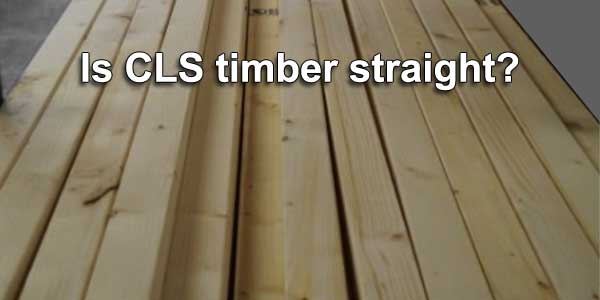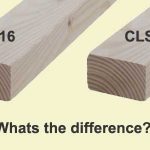In this article we will be looking at how straight and consistent CLS timber is. This will be compared with other types of wood, that you may find at a timber yard or builder’s merchant.
We will be looking at the general consensus, as well as my own personal experience using different types of timber, including CLS.
To answer the question simply, CLS timber is quite straight on average, and the quality does tend to be consistent. CLS is a graded timber, therefore it is more uniform than a lower quality, ungraded timber. As a result, this leads to a more consistent timber product.
Why is CLS considered straight good quality timber?

CLS (Canadian lumber standard) timber is a high-quality, graded product. This means it goes through a machine and visual grading process to determine its strength. This will include things like:
- Tightness and direction of grain.
- Size, frequency, and position of knots.
- Splits, cracks, and shakes in the timber
- Twisting and warping
Visual grading will also look at superficial defects, such as stains and discolouration caused by sap.
The two most common grades of timber that you will find CLS in, are C16 and C24. C16 is by far the most common in the UK and is perfectly adequate for most jobs.
C24 is slightly stronger and will have far fewer visual defects. The C24 graded timber will have a tighter straighter grain direction, as well as far fewer and smaller defects.
The grading process is carried out after the timber is kiln dried. This process reduces the timber to below twenty percent moisture content. Once dried, defects such as shakes, cracks and warping will become more apparent.
Due to fewer imperfections, C24 graded timber is better quality and the product is more uniform when it comes to consistency and straightness. However, this does come at a cost, and you should expect to pay more.
In reality, a C16 graded CLS is perfect for any type of first fix joinery work. It is perfect for building stud walls and other frames, that need a good quality timber. Whilst it may have slightly more defects than a higher graded timber, it will still be much better quality than a completely ungraded timber.
A common & similar alternative to CLS
You may also come across other planed timbers that are not CLS, but very similar and used in the same way. One common example is scant, this is very similar to CLS. However, 3X2 scant is slightly thicker and wider than CLS. It also has square corners, whereas CLS has rounded corners.
Scant is also generally graded C16, or ungraded. In my personal experience, it is of a slightly lower quality. With that said, they are very similar pieces of timber. CLS is just a little nicer to work with and has a slightly higher quality. It tends to be straighter and more consistent than scant.
Straightness of graded CLS vs ungraded and sawn timbers
The main advantage with a graded timber like CLS, is it’s a more quality controlled product. This means if you order a load of timber delivered. It is likely that there will be a good amount of consistency between lengths of timber. Even if you don’t go to the yard and select the timbers yourself, they will usually be pretty good.
You are bound to get a few warped and twisted timbers in the mix, but on the whole, they should be reasonably consistent. With that said, you can get 100% high quality by selecting the timbers yourself. If you do have the means to transport them, you should always try to select your own timbers.
By selecting the timbers yourself, you can avoid any defective pieces and you will also save on any delivery charges.
If you opt for a lower quality ungraded timber, you will pay less. Sometimes nearly half the price. However, you can be sure the quality will be lower and much less consistent. As a result, a delivery is far more likely to contain a higher percentage of lengths with defects and imperfections.
Real life example – The challenge of finding straight non graded timbers
Back in early 2020, I decided to convert an outbuilding at my home into an office. I had a tight budget for the job, and I was working with a small space. As a result I wanted to minimise costs and waste as little space as possible.
The outbuilding itself was a single skin brick shed, and it needed tanking and insulating. To achieve this, I decided to build a small stud wall inside the shed, to add insulation.
Ideally, I would have used CLS for this job, as it is good quality, straight timber. However, I decided to try and save an inch on each wall and reduce the cost significantly, by opting for a lower quality 2X2 ungraded, sawn timber.
The quality of this timber was significantly lower. However, it did cost a lot less and it fitted my 50mm Kingspan perfectly.
I selected the timber manually, and I would estimate that I rejected at least 80-90% based on low quality. I literally stood in the timber yard for an hour inspecting each piece one at a time, trying to find the good ones. The main reason for this, is it was very difficult to find nice straight pieces.
If I had this type of timber delivered, it would have been a disaster. There is no way the average quality would have been any good at all.
In contrast, had I been selecting CLS, the quality would have been much higher. I would have been happy with 90% of the timbers and on average they would have been much straighter.
Conclusion
CLS timber is a high-quality grade piece of wood, and it does tend to be quite straight and free of defects. That’s not to say that some timbers won’t be slightly warped or twisted. However, on average, you should be getting a good quality, straight piece of wood.
When it comes to timber quality, you do get what you pay for, but if you don’t need a timber that is strength graded and you are prepared to put in the work, you can dig through lower quality ungraded timber and still find some nice pieces.




